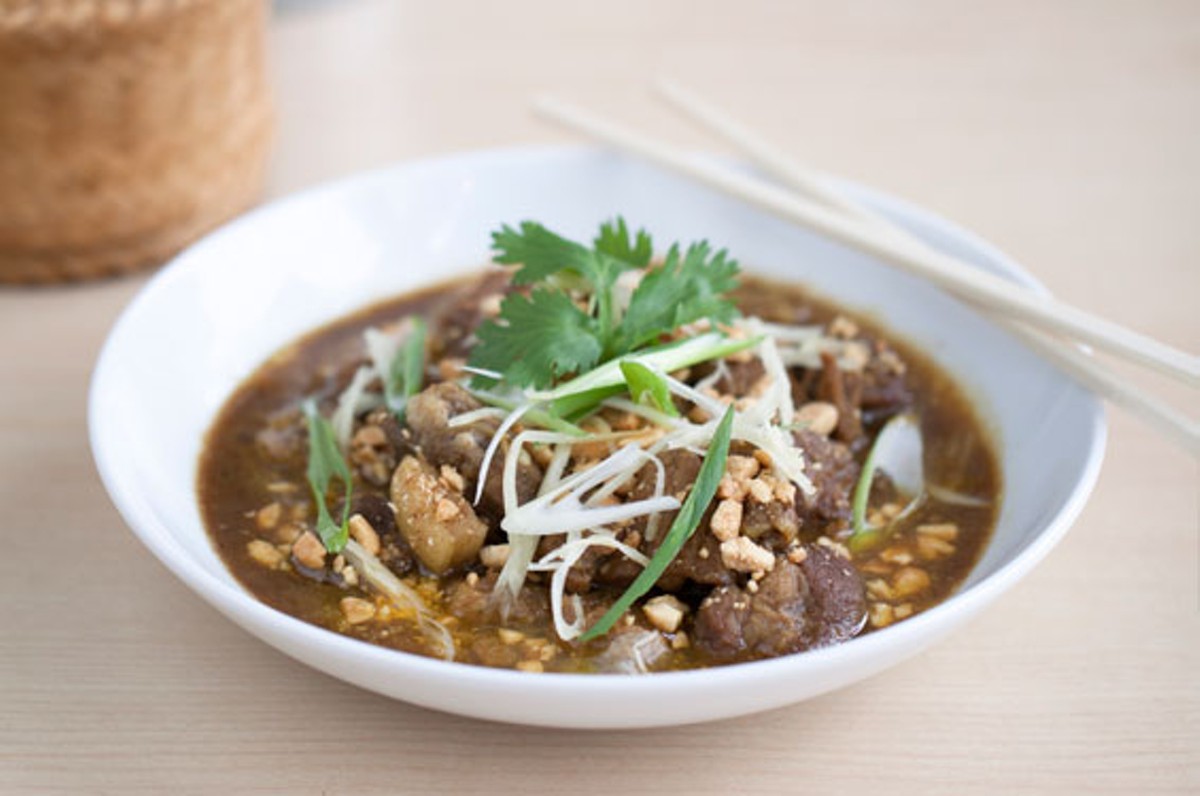In the dark days before Twitter and Yelp, before food porn overtook porn porn as the Internet's raison d'etre, you would have learned about a spot like Fork & Stix through word of mouth, if at all. This small, spare Thai restaurant is tucked away on a dead-end street off Delmar Boulevard at the eastern edge of the Loop. Its signage is minimal, effectively nonexistent: its name, on handwritten placards, in one window; a copy of the menu posted at the front door. The red glimmer of its tiny electronic OPEN sign is barely visible to passersby — and then only those who happen to be headed west on Delmar.
Today, of course, few spots escape the glare of the food media and food bloggers, not to mention the restaurant checklist brigade ("Been there, Instagrammed that"), and Fork & Stix is no exception. I dutifully reported its impending opening on Gut Check. I noted that its owners, the Wanna family, originally hail from the north of Thailand, so — got your checklist handy? — unlike most Thai restaurants here or elsewhere, it would feature dishes from that region, which is to say you'd be as likely to find influences from the cuisines of Laos or Burma as of Bangkok.
In the two months since I wrote that, people kept asking if I'd tried Fork & Stix. No, I told them. Not yet. They grew insistent. One friend called while en route to the restaurant and ordered me to join him for lunch, on his dime. He'd already eaten there five times. He was in love with the khao soi.
Khao soi is a curry-noodle soup that is the specialty of the northern Thai city of Chiang Mai. Or so the menu describes it. This doesn't quite prepare you for what arrives from the kitchen: a large bowl with noodles and grilled steak (or chicken, if you prefer) in a shimmering, iridescent yellow-orange broth atop which floats a towering tangle of fried egg noodles. On the side is a small dish with sliced red onion, pickled cabbage and a lime wedge. You add these, and a roasted-chile sauce, to taste.
The broth looks and, at first, tastes like a yellow-curry sauce: the sweetness of coconut milk balanced by spices both warm and bright. Though thinner in body than a typical curry sauce, the khao soi packs a much deeper flavor, its backbone a briny fermented funk of fish sauce and shrimp paste. Be liberal with those side garnishes: All of them, especially the pickled cabbage, strengthen the soup's punch. I've never eaten anything quite like khao soi, and even after I'd finished the beef and noodles in my bowl, I kept spooning up the broth, happily chasing more nuances of flavor than I can possibly recount here.
The hung lay curry is another northern Thai staple — "a Chiang Mai classic," the menu proclaims. This is so far removed from the typical Americanized Thai curry (red, green, etc.) that calling it a curry seems wrong, or at least incomplete. It features pork belly and pork loin in a beguiling sauce sweetened by palm sugar, soured by tamarind and then further enriched by ginger, turmeric and peanuts. You can add chile sauce if you like, but this dish succeeds without heat.
Slideshow: Photo tour of Fork & Stix
For a capsaicin rush, northern-Thai style, order sai oua with a side of naam prik nuum. Sai oua is grilled pork sausage with a powerful lemongrass note. As the menu suggests, the sausage pairs well with the brightly flavored and devilishly hot naam prik nuum, a chunky sauce of roasted green chiles with garlic, cilantro and shallots. With a side of sticky rice, this makes for a modest-size but satisfying meal.
Fork & Stix also offers more familiar Thai fare, all of it excellent: red and green curries; pad Thai and other stir-fried noodles; tom yum soup fragrant with lemongrass and kaffir lime and, if you request the spice level "hot," then hellishly so. Muu ping, a seemingly straightforward starter of skewers of grilled pork, offers surprisingly complex flavors: a sweet glaze tempered by coriander seeds and a garlic-pepper paste. The Wanna family also spent time in Japan, and the menu includes a few basic Japanese entrées as well: udon soup, yakisoba, teriyaki chicken.
Fork & Stix lacks a liquor license, which is too bad — rarely have I craved a cold, crisp beer as strongly as I did while eating sai oua and naam prik nuum. The Thai-style iced tea and coffee are excellent, and the condensed milk in the latter helps cut the chile heat.
A meal at Fork & Stix ends not with dessert but with a double take — more precisely, a double-double take. First you lift your head from your empty plate or bowl and snap back to the reality of an unassuming dining room: gray paint, not much natural light, a slate chalkboard across one entire wall. Did you really experience a great meal in this drab spot?
Then you step outside and remember again that Fork & Stix truly is a hidden gem, not merely off the main drag but easily forgotten in a neighborhood that's already home to four Thai restaurants, in a town that's home to dozens of them.
Now it's up to you to spread the word: Fork & Stix isn't merely new. It's unique. And it's terrific. Have you been there yet? Go!
Slideshow: Photo tour of Fork & Stix






